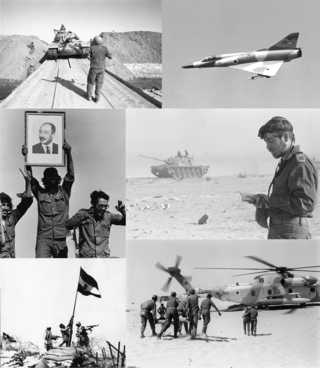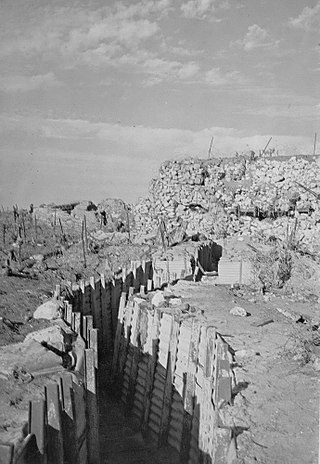
The Sinai Peninsula, or simply Sinai, is a peninsula in Egypt, and the only part of the country located in Asia. It is between the Mediterranean Sea to the north and the Red Sea to the south, and is a land bridge between Asia and Africa. Sinai has a land area of about 60,000 km2 (23,000 sq mi) and a population of approximately 600,000 people. Administratively, the vast majority of the area of the Sinai Peninsula is divided into two governorates: the South Sinai Governorate and the North Sinai Governorate. Three other governorates span the Suez Canal, crossing into African Egypt: Suez Governorate on the southern end of the Suez Canal, Ismailia Governorate in the center, and Port Said Governorate in the north.

The Yom Kippur War, also known as the Ramadan War, the October War, the 1973 Arab–Israeli War, or the Fourth Arab–Israeli War, was an armed conflict fought from 6 to 25 October 1973, between Israel and a coalition of Arab states led by Egypt and Syria. The majority of combat between the two sides took place in the Sinai Peninsula and the Golan Heights—both of which had been occupied by Israel in 1967—with some fighting in African Egypt and northern Israel. Egypt's initial objective in the war was to seize a foothold on the eastern bank of the Suez Canal and subsequently leverage these gains to negotiate the return of the rest of the Israeli-occupied Sinai Peninsula.

The War of Attrition involved fighting between Israel and Egypt, Jordan, the Palestine Liberation Organisation (PLO) and their allies from 1967 to 1970.

The Straits of Tiran are the narrow sea passages between the Sinai and Arabian peninsulas that connect the Gulf of Aqaba and the Red Sea. The distance between the two peninsulas is about 13 km. The Multinational Force and Observers monitors the compliance of Egypt in maintaining freedom of navigation of the straits, as provided under the Egypt–Israel peace treaty.
The history of the Israel Defense Forces (IDF) intertwines in its early stages with history of the Haganah.

The Bar-Lev Line was a chain of fortifications built by Israel along the eastern bank of the Suez Canal shortly after the 1967 Arab–Israeli War, during which Egypt lost the entire Sinai Peninsula. It was considered impenetrable by the Israeli military until it was overrun in less than two hours during Egypt's Operation Badr, which sparked the 1973 Arab–Israeli War.

David "Dado" Elazar was the ninth Chief of Staff of the Israel Defense Forces (IDF), serving in that capacity from 1972 to 1974. He was forced to resign in the aftermath of the Yom Kippur War.
The Rogers Plan was a framework proposed by United States Secretary of State William P. Rogers to achieve an end to belligerence in the Arab–Israeli conflict following the Six-Day War and the continuing War of Attrition.

Field Marshal Ahmad Ismail Ali was an Egyptian senior military officer who was Egypt's minister of war during the Yom Kippur War of 1973. He is best known for his planning of the attack across the Suez Canal, code-named Operation Badr.
The Arab–Israeli conflict began in the 20th century, evolving from earlier Intercommunal violence in Mandatory Palestine. The conflict became a major international issue with the birth of Israel in 1948. The Arab–Israeli conflict has resulted in at least five major wars and a number of minor conflicts. It has also been the source of two major Palestinian uprisings (intifadas).
Operation Boxer was an aerial offensive undertaken by the Israeli Air Force along the Suez Canal in July 1969. The first major IAF operation since the 1967 Six-Day War, the operation signaled a new phase in the War of Attrition.
Bir Gifgafa is an airfield in the Sinai, 90 km east of the Suez Canal. During the 1960s and 1970s it played a significant role in Arab–Israeli wars, at different times serving both Egypt and Israel.

The history of Egypt under Gamal Abdel Nasser covers the period of Egyptian history from the Egyptian Revolution of 1952, of which Gamal Abdel Nasser was one of the two principal leaders, spanning Nasser's presidency of Egypt from 1956 to his death in 1970. Nasser's tenure as Egypt's leader heralded a new period of modernisation and socialist reform in Egypt, along with a staunch advocacy of pan-Arab nationalism, and developing world solidarity. His prestige in Egypt and throughout the Arab World soared in the wake of his nationalisation of the Suez Canal Company in 1956, and Egypt's political victory in the subsequent Suez Crisis, but was damaged badly by Israel's victory in the Six-Day War.

The history of Egypt under Anwar Sadat covers the eleven year period of Egyptian history from Anwar Sadat's election as President of Egypt on 15 October 1970, following the death of President Gamal Abdel Nasser, to Sadat's assassination by Islamist fundamentalist army officers on 6 October 1981. Though presenting himself as a Nasserist during his predecessor's lifetime, upon becoming President, Sadat broke with many of the core tenets of the domestic and foreign policy ideology that had defined Egyptian politics since the Egyptian Revolution of 1952. In addition to abandoning many of Nasser's economic and political principles via the Infitah policy, Sadat ended Egypt's strategic partnership with the Soviet Union in favor of a new strategic relationship with the United States, initiated the peace process with the State of Israel in exchange for the evacuation of all Israeli military forces and settlers from Egyptian territory, and instituted a form of politics in Egypt that, whilst far removed from Egypt's pre-revolution democratic system, allowed for some multi-party representation in Egyptian politics. Sadat's tenure also witnessed a rise in governmental corruption, and a widening of the gulf between rich and poor, both of which would become hallmarks of the presidency of his successor, Hosni Mubarak.

Danny Matt was a decorated career Israeli military officer who served in the Israel Defense Forces from 1948 until 1992. He attained the rank of major general and fought in five Arab-Israeli wars, including the wars of 1948 and 1973. Among his many exploits was a daring operation involving leading a paratroop force across the Suez Canal during the Yom Kippur War. The operation was the beginning phase of a larger Israeli counter offensive that ultimately led to the victory of the Israeli army.

This article deals with the history and development of tanks of the Israeli Army, from their first use after World War II in the establishment of the State of Israel after the end of the British Mandate, and into the Cold War and what today is considered the modern era.

The Sinai Peninsula, which is a part of Egypt, has been militarily occupied by Israel twice since the beginning of the Arab–Israeli conflict: the first occupation lasted from October 1956 to March 1957, and the second occupation lasted from June 1967 to April 1982. Israel initially seized the Sinai Peninsula during the Suez Crisis, when it attacked Egypt in response to the Egyptian blockade against all Israeli shipping; the Egyptians had been contesting Israel's freedom of navigation through the Straits of Tiran and the Suez Canal since 1949, impacting the country's ability to import and export goods during the Israeli austerity period. Although the occupation allowed Israel to re-open the Straits of Tiran, the Suez Canal was closed until 1957, when Israeli troops withdrew from Egypt. In the mid-1960s, amidst warnings from Israeli officials that another blockade would be a casus belli, Egypt re-imposed the blockade against Israel and subsequently lost the Sinai Peninsula in the 1967 Arab–Israeli War. Like before, Israel's occupation allowed it to re-open the Straits of Tiran, but, once again, the Suez Canal was closed until 1975. For the next three years, Egypt, seeking to regain the territory it had lost, launched the unsuccessful War of Attrition against Israel. Later, a large-scale Egyptian military offensive against Israel, known as Operation Badr, triggered the 1973 Arab–Israeli War, which ended with the Israelis retaining control of the Sinai Peninsula. By 1979, the United States had successfully negotiated the Egypt–Israel peace treaty: the Egyptians recognized Israel as a sovereign state, recognized the Straits of Tiran and the Gulf of Aqaba as international waterways, and agreed to demilitarize along Israel's border. In exchange, Israel agreed to withdraw all civilians and soldiers from the Sinai Peninsula and return it to Egypt. On 25 April 1982, Israel's withdrawal concluded and Egypt has since left the Sinai Peninsula demilitarized, marking the first instance of peace between Israel and an Arab country.

Israeli passage through the Suez Canal and Straits of Tiran was restricted by Egypt, in cooperation with Saudi Arabia, for much of the time between the 1948 Arab-Israeli War and the 1967 Six-Day War. Since the Egypt–Israel peace treaty of 1979, Israel has enjoyed freedom of navigation through the Suez Canal and the Straits of Tiran.

The closure of the Suez Canal from November 1956 to April 1957 was caused by the Second Arab–Israeli war also known as the Suez Crisis in 1956. On 26 July 1956 Egyptian president Gamal Abdel Nasser nationalized the Suez Canal from British and French investors who owned the Suez Canal Company, causing Britain and France to devise a military operation with the help of Israel to invade the Egyptian Sinai Peninsula and have British and French paratroopers drop in to protect the Suez Canal, but the objective was to take the canal back. The United States and Soviet Union condemned the invasion and de-escalated the situation by early 1957.


















